#Cross-Platform App Development
Explore tagged Tumblr posts
Text
Top 5 Cross-Platform App Development Frameworks you need to Know in 2023

Cross-platform app development is the process of creating apps that can run on multiple platforms, such as Android, iOS, web, and desktop, with a single codebase. Cross-platform app development can offer many benefits for businesses, such as faster time to market, lower development cost, wider reach, and easier maintenance. However, cross-platform app development also comes with some challenges, such as performance issues, platform-specific features, and user experience differences. Therefore, choosing the right cross-platform app development framework is crucial for the success of your app project.
In this article, we will introduce you to the top 5 cross-platform app development frameworks that you need to know in 2023, and how they can help you create amazing apps for your business.
Flutter
Flutter is Google’s UI toolkit for building beautiful and native apps for mobile, web, and desktop from a single codebase. Flutter uses Dart as its programming language, which is a fast and expressive language that supports both object-oriented and functional paradigms. Flutter also uses a declarative approach to create UIs, which means that developers can describe what the UI should look like, rather than how to create it. Flutter also provides a rich set of widgets, animations, themes, and navigation features that can help developers create stunning and responsive UIs.
React Native
React Native is Facebook’s framework for building native apps for Android and iOS using React, a JavaScript library for building user interfaces. React Native allows developers to use the same codebase for both platforms, while still leveraging the native capabilities and features of each platform. React Native also uses a declarative approach to create UIs, which means that developers can describe what the UI should look like, rather than how to create it. React Native also supports hot reloading and live reloading, which means that developers can see the changes in their code without rebuilding or restarting the app.
Ionic
Ionic is an open-source framework for building hybrid apps for mobile, web, and desktop using web technologies, such as HTML, CSS, and JavaScript. Ionic allows developers to use the same codebase for multiple platforms, while still accessing the native features and functionalities of each platform through plugins. Ionic also provides a rich set of UI components, themes, icons, and animations that can help developers create beautiful and consistent UIs.
Continue reading Top 5 Cross-Platform App Development Frameworks you need to Know in 2023
#Cross-Platform App Development#app development#arizona#scottsdale#phoenix#app development company#flutter#reactnative#ionic
4 notes
·
View notes
Text
Integrating Multi‑Tenant SaaS with .NET and GraphQL: Real-World Architecture, Pitfalls & Best Practices
Introduction
As digital products shift toward subscription-based models, multi-tenant SaaS (Software as a Service) platforms have become the industry standard. One codebase. One database. Dozens, hundreds, or even thousands of clients—each expecting a personalized and secure experience.
If you're a .NET developer or ASP.NET developer building a scalable SaaS application, integrating GraphQL into your .NET stack can help you serve data flexibly while maintaining clean boundaries between tenants. But doing this right isn’t just about writing code—it’s about solving for architecture, authorization, data isolation, and long-term maintainability.
In this article, we’ll unpack how to build multi-tenant SaaS apps with .NET 8, ASP.NET Core, and GraphQL using Hot Chocolate. We’ll explore real-world strategies, architecture choices, and code examples to help you avoid common pitfalls.
What is Multi-Tenancy in SaaS?
In a multi-tenant application, a single codebase and infrastructure serve multiple customers (tenants). Each tenant has isolated data and a partially customized experience, but all share the same backend and frontend systems.
Common Multi-Tenant Models:
Model
Description
Use Case
Single-Tenant
One app & DB per customer
High compliance/enterprise
Shared DB, Separate Schemas
One DB, schema per tenant
Medium complexity
Shared Schema
One schema, tenant ID on each record
Best for scale and low cost
For most SaaS startups, shared schema with tenant ID filtering is the most efficient model.
Why Use .NET and GraphQL Together?
As an ASP.NET developer, you already have access to a rich backend framework. Pairing that with GraphQL gives you a powerful, modern API layer that:
Returns only the data your frontend needs
Minimizes round trips
Supports nested queries natively
Enables real-time updates via subscriptions
When you're building multi-tenant SaaS, GraphQL's flexibility allows you to expose tenant-specific data while hiding everything else behind a declarative query layer.
Multi-Tenant SaaS Architecture with .NET & GraphQL
Here's a modern architecture stack for a multi-tenant app using .NET:
Frontend: React, Angular, or Blazor (optional)
GraphQL Server: Hot Chocolate on ASP.NET Core
Business Logic Layer: Services injected with tenant context
Persistence: EF Core with tenant filters
Auth: JWT with tenant ID claim
Tenant Routing: Based on subdomain or header
Step-by-Step Integration Strategy
1. Tenant Identification
You need to identify the tenant on every request. Most common options:
Subdomain (e.g., company1.myapp.com)
Custom header (X-Tenant-ID)
JWT claim ("tenant_id": "company1")
Use a middleware to extract and inject tenant info:
csharp
CopyEdit
public class TenantMiddleware
{
public async Task InvokeAsync(HttpContext context, TenantService tenantService)
{
var tenantId = context.Request.Headers["X-Tenant-ID"];
tenantService.SetCurrentTenant(tenantId);
await _next(context);
}
}
Tip for .NET developers: Always inject TenantService into services and data layers.
2. GraphQL Endpoint Setup
Hot Chocolate makes it easy to define a GraphQL schema in .NET:
csharp
CopyEdit
public class Query
{
public IQueryable<Order> GetOrders([Service] IOrderService orderService) =>
orderService.GetOrdersForCurrentTenant();
}
Register your schema in Startup.cs:
csharp
CopyEdit
services
.AddGraphQLServer()
.AddQueryType<Query>()
.AddAuthorization();
Use [Authorize] or custom attribute policies for tenant-based access.
3. Enforce Data Isolation in EF Core
EF Core makes it easy to filter every query with a HasQueryFilter:
csharp
CopyEdit
modelBuilder.Entity<Order>()
.HasQueryFilter(o => o.TenantId == _tenantService.TenantId);
You can also use a base entity that includes the TenantId, then inject it automatically during insert/update operations.
ASP.NET developers, be cautious—this pattern only works if you never bypass your DbContext.
4. Role Management per Tenant
In multi-tenant systems, users may have different roles in each tenant.
Create a mapping table:
csharp
CopyEdit
public class TenantUser
{
public string UserId { get; set; }
public string TenantId { get; set; }
public string Role { get; set; } // Admin, Viewer, etc.
}
Check permissions in your services before executing logic:
csharp
CopyEdit
if (!userContext.HasRole("Admin")) throw new UnauthorizedAccessException();
Handling Common GraphQL Pitfalls in Multi-Tenant Systems
Over-fetching or under-fetching data
Fix: Use UseProjection(), UseFiltering(), UseSorting() in Hot Chocolate.
N+1 problem
Fix: Use DataLoader to batch queries and prevent extra DB calls.
Tenant info leakage in queries
Fix: Never allow client to supply tenantId in GraphQL input—always resolve it on the server.
Real-World Deployment Tips
CI/CD for Tenants
Use environment variables to inject tenant configs
Deploy shared GraphQL server
Optionally, create per-tenant frontends with dynamic branding
Tenant Testing Strategy
Use test accounts with different tenant claims
Create automated tests that simulate tenant context
Snapshot GraphQL responses per tenant for regression testing
Hosting Suggestions
Azure App Service, AWS ECS, or Kubernetes
Use Azure Front Door or AWS ALB for subdomain routing
Use Case: B2B CRM SaaS
A CRM platform wanted to serve 50+ companies using one app.
What they did:
Subdomain-based tenant routing
ASP.NET Core backend with GraphQL API
EF Core shared schema + filters
JWT auth with per-tenant role scoping
Results:
Tenant onboarding reduced from 3 days to 30 minutes
API reduced by 40% in size using GraphQL
All dev teams working independently with no data crossover
For .NET developers, this setup drastically reduced bug rates and improved observability.
Conclusion
Multi-tenant SaaS systems are the future of scalable software. Combining ASP.NET Core and GraphQL enables .NET developers to serve thousands of tenants with one highly optimized application—without compromising performance or security.
The keys are:
Identifying tenants early in the request pipeline
Structuring your services and GraphQL resolvers around tenant context
Enforcing role-based access and schema safety
Whether you're an ASP.NET developer building your first SaaS product, or a senior .NET developer refactoring a legacy app, now’s the time to embrace multi-tenancy—and GraphQL is a powerful ally.
#web development#cross-platform app development#custom application development#full stack development#android app development#ui ux design#frontend development#app development services#backend development#enterprise application development
0 notes
Text
Top 10 Features Every Business App Should Have
A well-built business app can streamline operations, engage customers, and grow your revenue — but only if it’s packed with the right features.
At Lunar Enterprises, we help businesses design apps that are not only beautiful and user-friendly but also functional and future-ready. Whether you’re building an internal operations tool or a customer-facing mobile app, these are the top 10 must-have features every business app should include.
✅ 1. User-Friendly Interface (UI/UX)
Your app's design directly impacts how users engage with it.
🎯 Why it matters:
Increases user retention
Reduces learning curve
Encourages repeat usage
💡 At Lunar Enterprises, our UI/UX experts focus on simplicity, accessibility, and brand consistency from the first wireframe.
✅ 2. Secure User Authentication
Protecting user data is non-negotiable.
🔒 Must include:
Login with email/phone & password
Two-factor authentication (2FA)
Biometric login (fingerprint/face ID)
🔧 We implement enterprise-grade security protocols in every app we build.
✅ 3. Push Notifications
Keep users informed and engaged in real-time.
📲 Benefits:
Remind users of updates, offers, deadlines
Drive engagement and conversions
Re-engage inactive users
📢 Pro tip: Keep messages personalized and timely to avoid notification fatigue.
✅ 4. In-App Support & Chat
Make it easy for users to get help when they need it.
💬 Popular options:
Live chat or AI chatbot
FAQs & help center
Support ticketing integration
🌐 Lunar Enterprises can integrate tools like Zendesk, Intercom, or custom-built chatbots.
✅ 5. Analytics & Reporting Dashboard
Track user behavior and business performance in real time.
📊 Useful for:
User engagement analysis
Sales tracking
Performance metrics
📈 We build in custom analytics or integrate with tools like Google Firebase, Mixpanel, or Amplitude.
✅ 6. Offline Access
Allow limited functionality without an internet connection.
🚫 Why it matters:
Enhances usability in remote areas
Keeps the app usable during network drops
Ensures critical tasks don’t stop
📲 This is especially vital for field service, sales, or logistics apps.
✅ 7. Seamless Integration with Business Tools
Your app should connect with existing software.
🔗 Common integrations:
CRM (Salesforce, Zoho)
ERP systems
Payment gateways
Email marketing platforms
🧩 At Lunar Enterprises, we ensure smooth third-party integrations that enhance productivity.
✅ 8. Scalability & Cloud Syncing
Your app should grow with your business.
☁️ Must-haves:
Cloud database (e.g., Firebase, AWS, Azure)
Real-time syncing across devices
Scalable backend architecture
🛠 We design systems that handle user growth without performance issues.
#Android App Development#iOS App Development#Cross-Platform App Development#Custom Software Solutions#Web Application Development#Enterprise Software Services#Full-Stack Development Services
0 notes
Text
A Complete Guide to App Development by Gratix
In today’s fast-paced digital era, mobile applications are no longer just convenient tools—they have become vital assets for businesses looking to engage users, streamline operations, and boost revenue. Whether you’re a startup aiming to make an impact or an established enterprise seeking innovation, understanding the App Development process is crucial for staying ahead in the competitive digital landscape.
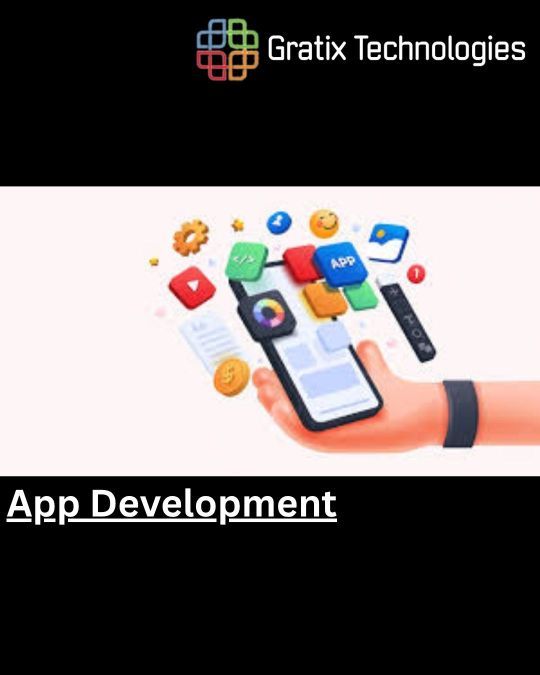
Why Mobile App Development is Essential
As of 2025, there are over 7.3 billion smartphone users worldwide, fueling the demand for user-friendly, responsive, and feature-packed apps. From e-commerce and fintech to healthcare and education, mobile applications are transforming the way businesses connect with their customers.
For companies like Gratix Technologies, investing in robust mobile App Development strategies is key to delivering agile, innovative, and scalable solutions that meet evolving market demands.
The App Development Process: Key Stages
Building a successful mobile app requires a systematic approach. Here’s a step-by-step guide to the App Development lifecycle:
1. Ideation and Research
Every great app begins with a strong idea. Define the purpose of your app, identify your target audience, and create a unique value proposition. Conduct thorough market and competitor research to validate the concept.
2. Planning and Wireframing
Once your idea is solid, design wireframes to map out the app’s functionality and user flow. Decide on the ideal technology stack and determine whether you’ll use native, hybrid, or cross-platform development.
3. UI/UX Design
An exceptional user experience (UX) is the backbone of any successful app. Use modern design tools like Figma or Adobe XD to craft intuitive, engaging, and visually appealing interfaces that enhance usability.
4. Development
This is where your app takes shape. Both front-end and back-end development are executed using powerful technologies—Swift and Kotlin for native apps or cross-platform frameworks like Flutter and React Native for faster, cost-effective solutions.
5. Testing
Before launch, rigorous testing ensures a bug-free, smooth user experience. Employ both manual and automated testing across devices and operating systems to ensure top-notch performance and compatibility.
6. Deployment and Maintenance
The final step involves launching your app on the Apple App Store and Google Play Store. Post-launch, regular updates, feature enhancements, and bug fixes are essential to maintaining user engagement and satisfaction.
Why Choose Gratix Technologies for App Development?
Selecting the right app development partner can make all the difference. Gratix Technologies offers end-to-end mobile app development services tailored to your business goals. From brainstorming the initial idea to delivering a polished, high-performance product, Gratix ensures every app is designed to drive growth, scalability, and user engagement.
App Development Trends to Watch in 2025
AI and Machine Learning (ML) Integration
Voice-Activated Interfaces
Augmented Reality (AR) Experiences
Progressive Web Apps (PWAs)
5G-Optimized Mobile Solutions
Staying ahead of these trends guarantees your app remains competitive and future-ready.
Final Thoughts
App Development goes beyond writing code—it’s about creating seamless digital experiences that solve real-world problems. By following a structured approach and partnering with experts like Gratix Technologies, your mobile app can evolve into a powerful tool for customer engagement and business success in 2025 and beyond.
Have an app idea? Connect with Gratix Technologies today and bring your vision to life with a team that’s dedicated to innovation, quality, and excellence.
#App Development#Mobile App Development#Android App Development#iOS App Development#Cross-Platform App Development#Gratix Technologies#App Development Company#UI/UX Design#App Testing
0 notes
Text
Top Reasons to Choose Flutter for Mobile App Development
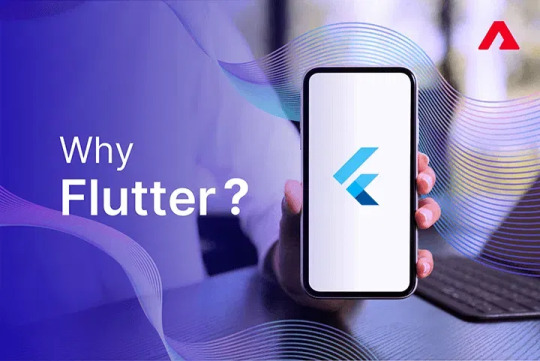
Discover why Flutter is a top choice for mobile app development in this comprehensive guide from Atharva System. Learn how Flutter enables faster development, cost efficiency, and seamless cross-platform compatibility using a single codebase. The guide highlights key advantages such as customizable UI, native-like performance, and strong community support. Whether you're a startup or an enterprise, this resource helps you understand how Flutter streamlines app development and delivers robust, high-performing mobile applications.
#Flutter mobile app development#Cross-platform app development#Flutter development guide#Benefits of Flutter framework
0 notes
Text
Mobile Apps Development: Transforming the Digital Landscape
In today’s fast-paced digital world, mobile applications have become a cornerstone of communication, business, entertainment, and productivity. From ordering food and booking a cab to managing finances and staying connected with loved ones, mobile apps touch nearly every aspect of our daily lives. As smartphone usage continues to rise globally, mobile app development has emerged as one of the most dynamic and innovative fields in the tech industry.
What is Mobile App Development?
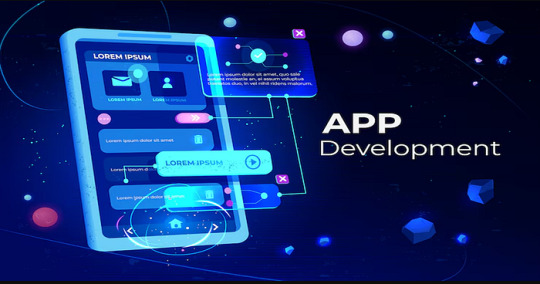
Mobile app development is the process of creating software applications that run on mobile devices like smartphones and tablets. These applications are typically developed for two major platforms: iOS (Apple devices) and Android (Google devices). The development process includes idea conceptualization, designing, coding, testing, and deployment, followed by maintenance and updates.
There are three main types of mobile apps:
Native Apps — Built specifically for one platform (iOS or Android) using platform-specific languages like Swift or Kotlin.
Hybrid Apps — Created using web technologies like HTML, CSS, and JavaScript, and wrapped in a native container.
Cross-Platform Apps — Developed using frameworks like Flutter, React Native, or Xamarin, allowing a single codebase to run on multiple platforms.
Why Mobile Apps Matter

The growing reliance on mobile devices has made mobile apps essential tools for businesses and individuals alike. Here’s why mobile apps are so influential:
Convenience: Mobile apps provide easy access to services and information from anywhere at any time.
User Engagement: With features like push notifications, mobile apps help businesses stay connected with their customers.
Revenue Generation: Many businesses use mobile apps to monetize through ads, subscriptions, or in-app purchases.
Brand Loyalty: Apps enable personalized experiences that build stronger relationships with users.
The Mobile App Development Process
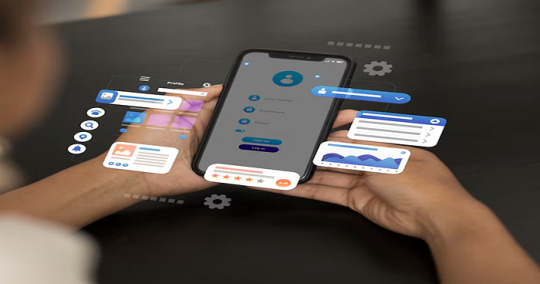
Developing a successful mobile app requires careful planning and execution. Here’s a breakdown of the key stages:
1. Idea and Market Research
Every app begins with an idea. Conducting thorough market research helps identify target audiences, analyze competitors, and determine the app’s unique value proposition.
2. Planning and Strategy
Once the idea is validated, developers and stakeholders plan the app’s features, design, platform, and technology stack. This stage also involves setting timelines and budgets.
3. UI/UX Design
User Interface (UI) and User Experience (UX) design are crucial for making the app intuitive and visually appealing. Tools like Figma, Adobe XD, and Sketch are commonly used to design user-friendly interfaces.
4. Development
Depending on the chosen platform and approach (native, hybrid, or cross-platform), developers begin coding the front-end and back-end components of the app. Integration with APIs, databases, and third-party services is also done here.
5. Testing
Before launch, the app goes through rigorous testing to identify bugs, security issues, and performance bottlenecks. Quality assurance ensures that the app functions correctly across various devices and operating systems.
6. Deployment and Launch
After successful testing, the app is submitted to the Apple App Store or Google Play Store for review and release. This stage includes preparing app store listings with descriptions, screenshots, and promotional materials.
7. Maintenance and Updates
Post-launch, developers monitor the app for issues, user feedback, and performance metrics. Regular updates are essential to add new features, fix bugs, and ensure compatibility with the latest OS versions.
Get Started with a Free Trial
Popular Tools and Technologies
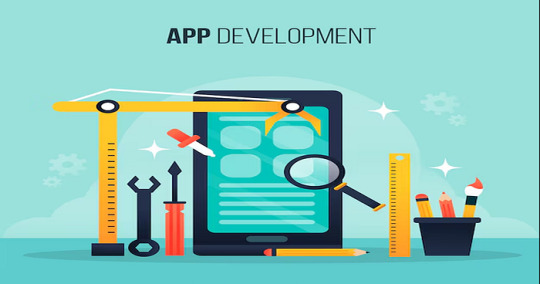
Mobile app developers leverage various tools to streamline development:
Android Studio and Xcode for native app development.
Flutter, React Native, and Xamarin for cross-platform development.
Firebase, AWS Mobile Hub, and Google Cloud for backend and hosting services.
Appium and TestFlight for app testing.
Trends Shaping the Future of Mobile App Development
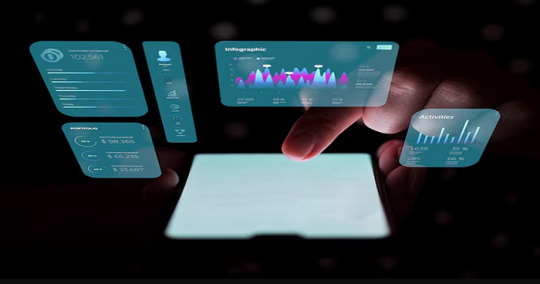
Mobile app development is continuously evolving with emerging technologies:
Artificial Intelligence (AI) and Machine Learning (ML) are powering smarter apps with personalized experiences.
Augmented Reality (AR) and Virtual Reality (VR) are transforming gaming, retail, and real estate apps.
5G technology is enhancing app performance with faster data transfer speeds.
Wearable devices and IoT integration are creating new opportunities for health, fitness, and smart home apps.
#Mobile App Deployment#Mobile App Testing#Mobile UI/UX Design#Android & iOS Development#Cross-Platform App Development
0 notes
Text

Android app development
D3 Logics is a top-notch mobile application development company in Jaipur, known for delivering high-quality and innovative mobile applications.
1 note
·
View note
Text
#Custom App Development#Mobile App Development Company#iOS & Android#Cross-Platform App Development#Flutter App Developers#Mobile App UI/UX Design
0 notes
Text
Explore the leading cross-platform app development frameworks of 2025 in our comprehensive guide. Learn how tools like Flutter, React Native, and .NET MAUI can streamline your development process, reduce costs, and deliver seamless user experiences across multiple platforms. Stay ahead in the evolving tech landscape with insights into the best frameworks for building versatile and efficient mobile app.
#Cross-Platform App Development#App Development Frameworks#Mobile App Development Framework#Cross-Platform Framework#Cross-Platform Apps
1 note
·
View note
Text
Native vs. Cross-Platform App Development: Which One is Right for You?

Introduction
In today’s digital era, businesses recognize the need for mobile apps to enhance customer engagement and boost revenue. However, a critical decision arises: Should you opt for Native or Cross-Platform App Development?
Both approaches have unique benefits, making it essential to choose based on your business goals, budget, and user experience expectations. If you want to develop a robust mobile application, partnering with a trusted app development company in Los Angeles can streamline the process.
Let’s dive into the details to help you determine the right choice for your business.
What is Native App Development?
Native app development refers to building applications specifically for one platform — iOS or Android — using platform-specific programming languages.
Technologies Used:
iOS Apps: Swift, Objective-C
Android Apps: Kotlin, Java
Advantages of Native Development:
✔ Superior Performance: Direct interaction with the device ensures smooth and fast performance.
✔ Better User Experience: Platform-specific UI/UX design enhances usability.
✔ Full Access to Features: Enables seamless integration with device hardware (GPS, camera, sensors, etc.).
✔ High Security: Native apps offer robust security features, making them ideal for fintech and healthcare industries.
Disadvantages:
✖ Higher Development Cost: Requires separate codebases for iOS and Android.
✖ Longer Development Time: Developing two separate apps takes more time.
What is Cross-Platform App Development?
Cross-platform development allows developers to create a single app that runs on both iOS and Android, using a shared codebase.
Popular Frameworks:
React Native (by Facebook)
Flutter (by Google)
Xamarin (by Microsoft)
Advantages of Cross-Platform Development:
✔ Faster Time-to-Market: A single codebase reduces development time.
✔ Cost-Effective: Businesses can save money by developing one app for both platforms.
✔ Easy Maintenance: Updates and fixes can be deployed simultaneously.
✔ Wider Reach: Launching on both iOS and Android increases user engagement.
Disadvantages:
✖ Performance Limitations: Not as fast as native apps.
✖ Limited Access to Platform-Specific Features: Some device-specific functionalities may require extra customization.
✖ UI/UX Differences: Apps may not feel as fluid as native ones.
Key Differences: Native vs. Cross-Platform
Native Development vs. Cross-Platform Development
Performance:
✅ Native: High
⚠️ Cross-Platform: Moderate
Development Cost:
❌ Native: Expensive
✅ Cross-Platform: Budget-Friendly
Development Time:
❌ Native: Longer
✅ Cross-Platform: Faster
UI/UX Experience:
✅ Native: Best
⚠️ Cross-Platform: Good, but not as smooth
Device Feature Access:
✅ Native: Full access
⚠️ Cross-Platform: Limited access
Security:
✅ Native: Highly Secure
⚠️ Cross-Platform: Moderate Security
When Should You Choose Native Development?
✔ If your app requires high performance (e.g., gaming, fintech, streaming apps). ✔ If you want the best user experience with seamless animations and smooth interactions. ✔ If your app needs deep hardware integration (GPS, camera, Bluetooth, etc.). ✔ If you have a higher budget and a long-term development plan.
Best Use Cases:
Banking & Fintech Apps
AR/VR Applications
High-Performance Gaming Apps
Video Streaming Platforms
When Should You Choose Cross-Platform Development?
✔ If you have a limited budget but want an app for both iOS and Android. ✔ If you need a faster time-to-market for MVPs or startup launches. ✔ If your app doesn’t require extensive device-specific features. ✔ If you want easier maintenance and updates.
Best Use Cases:
E-commerce Applications
Social Media Apps
Business Apps
MVPs (Minimum Viable Products)
Which One is Right for You?
The decision between Native vs. Cross-Platform depends on your specific business needs. If your goal is high performance and superior user experience, native is the best choice. If cost-efficiency and speed matter more, cross-platform development is the way to go.
Partnering with a top-rated app development company in Los Angeles can help you make the right decision based on your project requirements. At iQlance Solutions, we provide tailored app development services that align with your business goals.
Final Thoughts
Choosing between native and cross-platform development is a strategic decision. Whether you need high-performance native apps or cost-effective cross-platform solutions, iQlance Solutions is here to help. As a leading mobile app development company in Los Angeles, we offer end-to-end services to bring your app idea to life.
👉 Ready to build your app? Contact us today for a consultation!
Frequently Asked Questions
1. Is Native App Development Better Than Cross-Platform?
Native apps offer superior performance, better user experience, and full device access. However, they require higher investment and time. Cross-platform apps are more budget-friendly but have performance limitations.
2. Which Cross-Platform Framework is Best for App Development?
React Native and Flutter are the most popular frameworks. React Native is preferred for performance, while Flutter excels in UI design.
3. How Much Does It Cost to Develop a Mobile App?
The cost depends on factors like app complexity, features, and development approach. Native apps cost more, while cross-platform apps are more budget-friendly.
4. Can I Convert a Native App Into a Cross-Platform App?
Yes, but it requires redevelopment. A trusted app development company in Los Angeles can guide you on the best approach.
5. How Do I Hire App Developers for My Project?
Look for experienced developers with a strong portfolio. You can hire app developers from iQlance Solutions to build a high-quality mobile app tailored to your business needs.
#Native app development#app development company in Los Angeles#Cross-platform app development#mobile app development company
0 notes
Text
React Native Vs. Flutter: Which Framework is Right for Your App?
In this blog we shares all about React Native Vs. Flutter: Which Framework is Right for Your App? And When to Choose Flutter App Development, When to Choose React Native App Development. If you want to Build the best mobile application development company in Rajkot, Contact Aphonic Solutions now!

#cross-platform app development#mobile application development company in Rajkot#React Native Vs. Flutter#When to Choose Flutter App Development#When to Choose React Native App Development
0 notes
Text
Native vs Cross-Platform Development Which is Right for Your App

When developing a mobile app, there are two main approaches to choose from: native development and cross-platform development. Native development involves creating separate apps for each platform (Android and iOS), while cross-platform development allows you to create a single app that can be deployed to multiple platforms.
Each approach has its own advantages and disadvantages, so it is important to choose the right one for your specific needs. In this article, we will compare native and cross-platform development and help you decide which approach is right for you.
Native App Development
Native development is the traditional approach to mobile app development. It involves creating separate apps for each platform (Android and iOS). This allows you to create apps that are fully optimized for each platform and that take advantage of all the latest features and functionality.
Advantages of Native App Development:
Performance: Native apps typically offer better performance than cross-platform apps. This is because they are written in the native programming language for each platform, which allows them to take advantage of the platform’s specific hardware and software features.
User experience: Native apps also tend to have a better user experience than cross-platform apps. This is because they are designed specifically for each platform and take advantage of the platform’s native UI elements and design guidelines.
Security: Native apps are generally more secure than cross-platform apps. This is because they are written in the native programming language for each platform, which makes it more difficult for attackers to exploit vulnerabilities.
Disadvantages of Native App Development:
Cost: Native development is typically more expensive than cross-platform development. This is because it requires you to develop two separate apps, one for Android and one for iOS.
Time: Native development also takes longer than cross-platform development. This is because you need to develop two separate apps, one for Android and one for iOS.
Complexity: Native development is more complex than cross-platform development.
Cross-Platform App Development
Cross-platform development is a newer approach to mobile app development. It allows you to create a single app that can be deployed to multiple platforms (Android and iOS). This can save you time and money, but it may come at the cost of performance and user experience.
Continue reading Native vs Cross-Platform Development Which is Right for Your App
#Native vs Cross-Platform Development#app development#arizona#scottsdale#phoenix#mobile app development company#Native App Development#Cross-Platform App Development
2 notes
·
View notes
Text

Niotechone is a top-tier web, mobile app, and custom software development company with 13+ years of expertise. Delivering over 1,000 successful projects in healthcare, fintech, eCommerce, and logistics, they specialize in scalable, secure, and user-friendly digital solutions tailored to meet complex business requirements with precision and innovation.
0 notes
Text
Mobile App Development Lifecycle: What You Need to Know
Developing a mobile app involves more than just writing code — it’s a strategic, step-by-step process that transforms your idea into a user-ready product.
Whether you're a startup or an established brand, understanding the mobile app development lifecycle is key to building a successful app that delivers real value.
At Lunar Enterprises, we’ve helped businesses across industries design, build, and launch high-performing mobile apps. In this blog, we break down each stage of the app development journey — from ideation to launch and beyond.
📱 What Is the Mobile App Development Lifecycle?
The app development lifecycle is a series of defined stages that take your idea through planning, design, development, testing, deployment, and maintenance. Each phase is essential to ensuring your app is functional, scalable, and user-friendly.
✅ Key Stages of the Mobile App Development Lifecycle
1. Discovery & Requirement Gathering
Before writing a single line of code, we begin with a deep dive into your business goals, user needs, and technical requirements.
🔍 Activities:
Market research & competitor analysis
Target audience identification
Feature planning & user journey mapping
Budget and timeline estimation
🛠 At Lunar Enterprises, we offer free consultations to help you shape a clear product roadmap.
2. UI/UX Design
This phase focuses on creating an intuitive and engaging user experience. A well-designed app boosts usability, engagement, and retention.
🎨 Tasks Include:
Wireframes & user flow creation
UI prototypes & mockups
Visual branding & interaction design
✨ Our design team ensures your app is visually appealing and aligned with your brand identity.
3. App Development
Now the actual coding begins. Based on your chosen platform (Android, iOS, or cross-platform), we start developing the frontend and backend systems.
💻 Tech Stack:
Flutter / React Native (cross-platform)
Kotlin / Java (Android)
Swift / Objective-C (iOS)
Node.js / Firebase / AWS for backend services
🛠 At Lunar Enterprises, we follow agile development — delivering working modules in sprints for faster feedback.
4. Quality Assurance (QA) & Testing
Before launch, rigorous testing is done to ensure the app works smoothly under real-world conditions.
✔️ Tests Include:
Functional testing
Performance & load testing
Security testing
Usability & compatibility testing
🐞 We use automated and manual testing to catch bugs early and ensure a flawless user experience.
5. Deployment & Launch
Once your app passes QA, it's time to launch!
🚀 Tasks:
App Store and Google Play submission
App store optimization (ASO)
Launch strategy & marketing support
📢 Lunar Enterprises ensures your app meets all store guidelines and launches successfully across platforms.
6. Post-Launch Support & Maintenance
Development doesn’t stop after the app goes live. Continuous updates, user feedback, and performance monitoring are vital to long-term success.
🔁 Services Include:
Bug fixes & performance enhancements
Version updates for OS changes
Feature upgrades based on user feedback
Ongoing support and analytics
🔧 Our support team ensures your app stays relevant and competitive long after launch.
🧠 Why the Lifecycle Matters
Understanding each phase helps you:
Make informed decisions
Manage timelines and budgets better
Align development with business goals
Reduce risk of delays and poor performance
🌟 Why Choose Lunar Enterprises?
✅ End-to-end app development — from idea to launch ✅ Expertise in cross-platform, Android, and iOS development ✅ Agile delivery and transparent communication ✅ Scalable, secure, and user-centric solutions ✅ Post-launch support that grows with your business
#android app development#Android App Development#iOS App Development#Cross-Platform App Development#Custom Software Solutions#Web Application Development#Enterprise Software Services#Full-Stack Development Services
0 notes
Text
Unlock the Potential of Your Business with Our Flutter App Development Services

"The future of mobile app development is cross-platform, and Flutter is leading the way."
In today's fast-paced digital world, having a high-performing, scalable, and visually appealing mobile app is no longer an option—it’s a necessity. Businesses across industries are leveraging mobile applications to enhance customer engagement, streamline operations, and boost revenue. However, the challenge lies in finding a cost-effective solution that delivers a native-like experience across multiple platforms.
At Shine Infosoft, we specialize in Flutter app development—a powerful cross-platform framework by Google that enables businesses to build feature-rich mobile applications with a single codebase. Whether you're a startup looking to launch an MVP or an enterprise seeking a high-performance app, our Flutter development services offer speed, flexibility, and cost-efficiency without compromising on quality.
In this blog, we’ll explore: ✅ Why Flutter is the best choice for businesses looking to build cross-platform apps. ✅ How Shine Infosoft delivers tailored Flutter app solutions to meet unique business needs. ✅ Success stories of businesses that have scaled with our Flutter development expertise.

By the end, you'll understand why partnering with Shine Infosoft for Flutter app development is the smart choice to future-proof your business. Let’s dive in! 🚀
Why Flutter for Business Growth?
Cross-Platform Efficiency
Develop for both iOS and Android using a single codebase, reducing development costs.
Faster time-to-market with quick iterations and seamless updates.
Eliminate the need for maintaining separate development teams for different platforms.
High Performance & Native-Like Experience
Uses Dart programming for smooth animations and responsive UI.
Faster rendering with the Skia graphics engine, reducing load times.
Delivers 60fps and 120fps animations for an ultra-responsive user experience.
Cost-Effective Development
Saves development costs compared to building separate native apps.
Reduces maintenance efforts with unified code.
Simplifies debugging with a single testing framework for multiple platforms.
Scalability & Flexibility
Supports MVP development for startups to test their business ideas quickly.
Easily integrates with existing systems and third-party APIs.
Scales to meet the demands of enterprise-level applications.
Strong Community & Google Support
Backed by Google, ensuring continuous updates and improvements.
A growing developer community for extensive resources and plugins.
Regular improvements with robust support for emerging technologies.
Shine Infosoft’s Flutter App Development Services
Custom Flutter App Development
Tailored mobile solutions designed for different industries, from e-commerce to healthcare.
Scalable architecture to support future enhancements and business growth.
UI/UX Design Excellence
Creating intuitive and visually appealing app interfaces using Flutter’s rich widget ecosystem.
Enhancing user engagement with seamless navigation and superior user experience.
Flutter for Startups & Enterprises
MVP development for startups to launch quickly and validate business ideas.
Enterprise-grade app solutions with robust security, compliance, and performance.
API & Third-Party Integrations
Payment gateways, CRM, cloud storage, and analytics integration for enhanced functionality.
Optimizing backend connectivity to ensure seamless app performance.
App Maintenance & Upgrades
Ongoing support to monitor app performance and resolve bugs.
Regular updates to align with the latest Flutter versions and OS updates.
Performance tuning to enhance speed, security, and user satisfaction.
How We Empower Businesses with Flutter
E-commerce App Development
Developed a seamless shopping experience with real-time inventory updates and intuitive product browsing.
Integrated secure payment gateways for smooth transactions and higher conversion rates.
Enhanced customer engagement with personalized recommendations and push notifications.
Healthcare App Innovation
Built a telemedicine app with real-time video consultations and HIPAA-compliant security features.
Implemented AI-driven health tracking and data analytics for improved patient care.
Enabled seamless integration with wearable devices for continuous health monitoring.
Fintech App Development
Designed a secure mobile banking app with multi-layer authentication and real-time fraud detection.
Integrated AI-powered chatbots for 24/7 customer support.
Optimized app performance to ensure lightning-fast transactions and reduced downtime.
On-Demand Service App
Developed a fully functional on-demand booking platform for service providers.
Implemented location-based services for enhanced user convenience.
Provided seamless user authentication with social media and email login options.
Why Choose Shine Infosoft for Flutter Development?
✅ Experienced Team: Our developers have extensive expertise in Flutter and mobile technologies, ensuring high-quality app development. ✅ Agile Development Process: Ensuring timely delivery with continuous iteration and client feedback. ✅ Competitive Pricing: Cost-effective solutions with no compromise on performance and design. ✅ Proven Track Record: Successfully deployed Flutter applications across various industries, helping businesses scale rapidly. ✅ End-to-End Solutions: From concept to deployment, we offer full-cycle Flutter app development services.
Conclusion & Call to Action
🚀 Shine Infosoft specializes in Flutter app development, helping businesses build fast, reliable, and scalable mobile applications. Our expertise ensures that your app meets the highest standards of performance, security, and user experience.
💡 Ready to take your business to the next level? Contact Shine Infosoft today for a free consultation, and let’s build your next-generation Flutter app! 🎯
Source
#Hire Flutter Developer#Flutter Development Service#Flutter Development Company#Best Flutter Development Service#Mobile App Development in Ahmedabad#Flutter Development in Ahmedabad#Flutter Development in India#Cross-Platform App Development
0 notes
Text
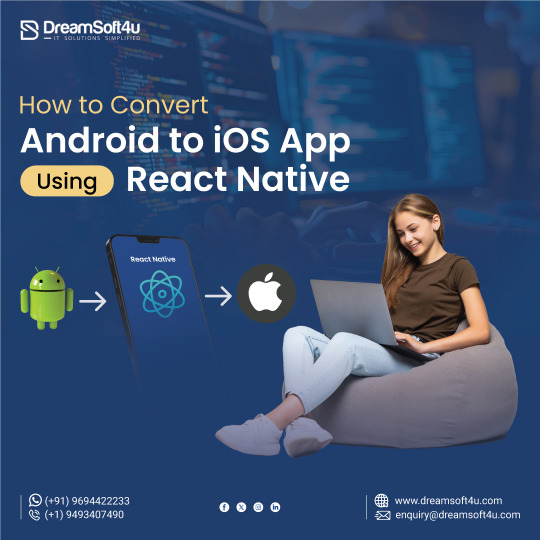
Are you planning to convert your Android to iOS app using React Native? If Yes, then this guide will help you. Nowadays, React Native has become the ultimate solution for businesses who want to build a mobile app. One thing that makes react native most popular for developers is that developers can write code once and build an app for both Android and iOS and don’t need to write separate code for each OS.
#ios app development company#ios app development services#ios app developer#cross-platform app development#android to ios app#react native mobile app development#android app development company
1 note
·
View note